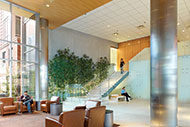
View "Sustainable performance" Gallery
Health systems are recognizing sustainability as central to their mission, a fact reflected in the design, construction and operations of health facilities. “Sustainability is fundamentally about health,” says Robin Guenther, FAIA, LEED AP, sustainable health care design leader with the New York office of Perkins+Will. For the health of patients, visitors, staff and the larger community, providers are working to create facilities with minimal negative environmental impact.
Looking to the future
“Looking at the future of health care, hospitals and health care systems are caring for the community,” says Paul Stein, chief operating officer, MaineGeneral Health, Augusta. With changing payment structures, providers are adopting a model of health management and preventive care. “We’re trying to change the way folks look at our health care system and facilities,” says Stein. Rather than places to come when you’re sick, health facilities should be seen as places to be well and become educated about health, he says. Sustainable features contribute to this impression.
They also create more of a healing environment for patients, visitors and staff, enabling everyone in the facility “to do what they’re there to do, better,” says Gail Vittori, LEED fellow, co-director of the Center for Maximum Potential Building Systems, Austin, Texas, and co-author, with Guenther, of Sustainable Healthcare Architecture (John Wiley & Sons Inc., 2013). Sustainable designs and operations increase human health, productivity and safety, says Barbara Hamilton, LEED Green associate, sustainability manager, Palomar Health, Escondido, Calif. Since the health system opened Palomar Medical Center in Escondido, a 288-bed facility designed as a pilot project for the Green Guide for Health Care, “patient satisfaction scores have gone up dramatically,” she says.
According to Mary Larsen, manager for environmental stewardship, Advocate Health Care, Downers Grove, Ill., ensuring the safety of the environment also can be a bottom line-driven decision. Advocate has realized more than $15 million in savings from energy-efficiency, reduced consumption and overall waste-minimization since 2008. “The more conservation of resources, the more money we have to invest in our health care ministry,” Larsen says.
Return on investment
“You can’t afford not to [have sustainable facilities],” says Mark Webb, senior vice president of facilities administration, University Health System, San Antonio, Texas. Last year, the health system opened a six-story clinical pavilion on its Robert B. Green Campus in San Antonio, earning a Gold rating from the U.S. Green Building Council’s LEED program. The clinical pavilion includes efficient equipment and building operating systems designed to use 33 percent less energy than required by code, reflective paving and roofing materials that reduce the heat-island effect and a system for harvesting condensate from the central energy plant for power generation and landscape irrigation, among other sustainability features. The health system expects to receive LEED Gold as well for similar measures taken in the design of the 10-story, 420-bed Sky Tower at University Hospital, which opened this April. For either project, “we didn’t do anything with a payback over three years,” says Webb.
MaineGeneral Health anticipates a similar payback period for sustainable features of the Alfond Center for Health, a 640,000-square-foot, 192-bed replacement hospital in Augusta, a LEED Gold project that was completed under budget. The hospital’s heat-recovery system is expected to pay for itself in a year and the high-performance exterior, which Stein says was designed to be “as efficient as possible,” within three years.
The geothermal heat pump system at Methodist Olive Branch (Miss.) Hospital, a 210,000-square-foot, 100-bed facility, was “a big cost” for Methodist Le Bonheur Healthcare, Memphis, Tenn., says Richard Kelley, PE, LEED AP BD+C, project manager, corporate facilities management. The system, which involved drilling 200 bore holes 300 feet deep, has a life-cycle cost estimated at upward of $600,000. But with energy savings projected to result in a five-year return on investment, “we could do it with a clear conscience,” Kelley says.
Through a combination of conservation and renewable energy production, Gundersen Health System, La Crosse, Wis., is working to become energy-independent by the end of 2014, a project that “saves the organization millions and millions of dollars every year,” says Kari Houser, director of facility planning, construction and project management. The system’s new hospital, the Legacy Building, opened in January in La Crosse. The 430,000-square-foot, 325-bed hospital is designed to operate at 115 kBtu per square foot per year, which the hospital calculates will save about $660,000 annually at today’s energy rates; this is compared with benchmark median hospitals in the region, which require 250 kBtu per square foot per year. The Legacy Building’s energy savings are due in large part to a geothermal heat pump system that comprises 150 wells each 400 feet deep. Over the 50- to 100-year life of the Legacy Building, energy, water and labor costs will only go up, making the hospital’s efficiency measures even more valuable, Houser notes. “We’re making decisions that will help reduce the cost of care,” she says.
On-site power generation protects against energy price uncertainty, says Ramé Hemstreet, vice president, national facilities services operations, Kaiser Permanente, Oakland, Calif., and the organization’s chief energy officer. “With power purchase agreements with solar developers, costs per kilowatt-hour are locked in for 15 to 20 years,” Hemstreet says. Kaiser Permanente has installed solar panels at 13 locations, ranging from hospitals to a distribution center, as part of a sustainable energy policy to reduce the organization’s greenhouse gas emissions by 30 percent by 2020, from a baseline established in 2008. Last year, these arrays generated 18 million kilowatt-hours of electricity. Hemstreet says the system has more than 100 sites in California alone that could be added to this portfolio, for an up to 50-megawatt increase in generation capacity. “It’s cost-effective and the right thing to do,” he says.
Sustainability can provide a variety of efficiencies, notes Jon Utech, senior director for Cleveland Clinic’s Office for a Healthy Environment. For example, the organization specified light-emitting diode lighting instead of compact fluorescent lights for a facility project currently in the planning phase, a higher first cost it expects to recoup through future operational savings on bulb replacement, maintenance costs and energy costs.
Material impact
Sustainable materials can improve the overall environment for patients and staff. “If we’re using nontoxic materials in the building itself … it’s a healing space that’s not causing harm,” says Hamilton.
“Materials define the indoor environment,” says Vittori, noting the manufacturing industry has been responsive to concerns about indoor air quality over the past decade, developing products that emit low or no volatile organic compounds and that avoid chemicals of concern. Kaiser Permanente is working with manufacturers to meet the requirements of the health system’s new furnishings standard, which states that upholstered furniture in new or remodeled buildings should not contain added fire-retardant chemicals. Materials that can be maintained through green cleaning practices, such as flooring that can be cleaned with water rather than chemical waxing and stripping, are being adopted as standards by several health systems.
High-performance building envelopes can reduce energy costs and increase comfort in a building too. John Messervy, AIA, corporate director, design and construction, Partners HealthCare, Boston, says triple-paned windows in the patient rooms of Spaulding Rehabilitation Hospital, a LEED Gold facility Partners HealthCare opened last year in Boston, eliminated the need for baseboard radiation in these rooms. According to Houser, the windows, roofing system and building assembly of Gundersen Health System’s Legacy Building are responsible for 30 percent of the facility’s energy savings.
At Palomar Medical Center, the exterior wall system is “a huge component” of the facility’s energy-efficiency, says Frances Moore, AIA, LEED AP BD+C, associate principal, CO Architects, Los Angeles. The building’s undulating facade, along with projections, sunscreens and high-performance glass, all contribute to reducing the amount of heat gain the air handlers must manage at the 740,000-square-foot building.
Palomar Medical Center’s ground-to-ceiling glass panels are fabricated of Solarban 60 and Solarban 70XL low-emitting glass by PPG Industries Inc., Pittsburgh. Solarban glass can transmit high levels of light while blocking solar heat gain, reducing a facility’s need for artificial light and air conditioning, says Chuck McMullen, national architectural and sales manager, PPG Industries. Health facilities are being designed with larger windows to provide views and natural light to help the healing process, he notes. Glass with a clear appearance, advanced light transference and solar control properties is designed to meet the aesthetic and performance requirements of health care.
The lobby of Methodist Olive Branch Hospital features electronically controlled dynamic glass that automatically tints to reduce solar heat gain and glare as the sun rises; the glass then clears for greater visibility when the sky darkens. View Inc., Milpitas, Calif., manufactures the glass in the hospital’s hometown. According to Kelley, the number of heat pumps required for the hospital lobby was cut from four to two due to this material’s capacity to control heat gain.
Green features
Integrating nature into a facility literally can be one of the greenest ways to achieve a sustainable design. Cleveland Clinic’s Twinsburg (Ohio) Family Health and Surgery Center, a LEED Gold-rated facility, is designed to maximize green space, with walking paths and natural preservation areas easily viewable by patients and staff. Gundersen Health System’s Legacy Building has two rooftop terraces, one for patients and family members and another for hospital staff. By adding ground-level and rooftop gardens as part of the Sky Tower at University Hospital project, University Health System increased the system’s overall green space by almost one-quarter. Advocate Health Care plans to create two green roofs in modernizing Advocate Good Shepherd Hospital, Barrington, Ill., a project targeting LEED Silver. Palomar Medical Center features balconies planted with trees on every patient floor and a 1.5-acre green roof atop the second floor of the medical and surgical areas. Large windows are located throughout the medical center, even in the operating rooms, with views to the outdoors. “This is what sustainable health care design is all about: supporting the mission of the hospital, with its sophisticated technology, in the most natural and beautiful environment,” says Moore.
Sustainable features also can be found in less beautiful, but innovative, locations. Hamilton says one of the most environmentally friendly elements of Palomar Medical Center is the “gigantic” back dock, which has room for equipment to manage much of the hospital’s waste stream on-site. This includes a steam sterilizer unit for regulated medical waste, a food waste composting system and a recycling compactor. Parking garages at Cleveland Clinic are equipped with sensors that read employee badges and automatically open the entrance to the garage, to reduce idling time and, therefore, the organization’s carbon footprint.
Leading by example
Health care systems are using their facilities to model healthy behavior, whether as part of a faith-based call to protect the environment, as stewards of the public trust (and taxpayer dollars) or as anchors in their communities with a responsibility to instill health. “We’re trying to lead by example,” says Stein.
“We see sustainability as a health issue,” adds Hemstreet. “Our mission is to improve the health of our members and the communities we serve. So we’re focused on doing our part … to reduce our environmental footprint.”
is a freelance writer based in Homewood, Ill., and a frequent contributor to Health Facilities Management.
Sleuthing out ways to save on energy use
Despite the energy demands of health care, there are many opportunities for energy conservation at health facilities. “There are whole areas of our facilities that aren’t 24/7,” notes Kari Houser, director of facility planning, construction and project management, Gundersen Health System, La Crosse, Wis. Actions like regulating the thermostat and turning off the lights in these areas after hours “make enormous differences in energy consumption for facilities,” she says. Multiplied over the millions of square feet that can make up a health system like Gundersen, “anything you can do, even small things, will add up to a big impact,” she adds.
According to Robin Guenther, FAIA, LEED AP, sustainable health care design leader with the New York office of Perkins+Will, most hospitals could gain 20 to 25 percent energy savings through efforts like retrocommissioning. Palomar Medical Center, Escondido, Calif., is undertaking a continuous commissioning process with the local utility company, San Diego Gas & Electric, to ensure that the building runs optimally, says Barbara Hamilton, LEED Green associate, sustainability manager, Palomar Health. An energy management system at the hospital provides daily information about building performance.
The medical center is zoned for efficient operations, a design that started early in the project, says Frances Moore, AIA, LEED AP BD+C, associate principal, CO Architects, Los Angeles. Mechanical equipment is located on Level 3 of the facility, with different air-handling units serving different parts of the building, such as patient rooms or the diagnostic and treatment block. Each is tailored to specific code requirements to provide service in the most efficient way.
In existing facilities, “there are 10,001 things you can do” to improve energy-efficiency, from educating users to installing automatic control systems or variable-speed drives," says Ramé Hemstreet, vice president, national facilities services operations at Kaiser Permanente, Oakland, Calif., and the organization’s chief energy officer. “Make every maintenance project an energy project,” he advises. New construction is a chance to install advanced, energy-efficient technologies like the active chilled-beam system planned for Kaiser Permanente’s San Diego Central Hospital Medical Center, which is expected to help the facility operate 30 percent more efficiently when it opens in 2017.
Partners HealthCare, Boston, installed combined heat and power plants at new clinical buildings to provide a base load for utilities and make the building more resilient against events like extreme weather, says John Messervy, AIA, corporate director, design and construction. As Messervy notes, a sustainable building that is operating at a lower energy benchmark can stretch its emergency capacity over a longer period. “It’s a secondary, but extremely important, benefit,” he says. “Sustainability and resiliency are intertwined in many ways.”
Every drop counts in water conservation
Hospitals require great amounts of water for clinical, environmental services and facilities management activities. According to Gail Vittori, LEED fellow, co-director of the Center for Maximum Potential Building Systems, Austin, Texas, the average U.S. hospital has been estimated to use about 300 gallons of water per bed per day. To increase sustainability, health providers are finding a number of ways to conserve and manage water.
MaineGeneral Health, Augusta, uses low-flow faucets and fixtures in its facilities. In addition, the health system collects rainwater for use with hospital chillers and boilers, using as much runoff from roofs and parking areas as possible, says Paul Stein, COO.
Storm water collection is also one of the water management strategies used by University Health System, San Antonio, Texas. Water conservation is an important local issue for the health system, notes Mark Webb, senior vice president of facilities administration. For the recent Sky Tower at University Hospital project, the health system worked with San Antonio Water System, the local water utility, to have a recycled water line extended to the building site. Through careful water management, the health system will decrease its potable water usage at the University Hospital campus despite doubling the amount of building space from 1 million to 2 million square feet, as well as adding a 3,300-space parking garage, new central plant and nearly 25 percent more green space.
Kiowa County Memorial Hospital, a 50,000-square-foot, 15-bed critical access hospital located in Greensburg, Kan., earned LEED Platinum for its facility, which is designed to reduce overall water use by 57 percent, according to the Department of Energy’s National Renewable Energy Laboratory. The hospital has low-flow fixtures installed throughout and a system that uses collected rainwater to flush toilets.
Strategic water usage helps health providers to achieve a balance between proper operations and water-efficiency, says Ramé Hemstreet, vice president, national facilities services operations, Kaiser Permanente, Oakland, Calif., and the organization’s chief energy officer. To deal with the water crisis in California, Kaiser Permanente instituted a national sustainable water policy to reduce its water use and ensure that communities have long-term access to high-quality water supplies. Hemstreet says measures to reduce consumption include xeriscaping (landscaping without the need for supplemental water) and on-site solar power generation, which reduces the amount of water required to generate power by other means.





